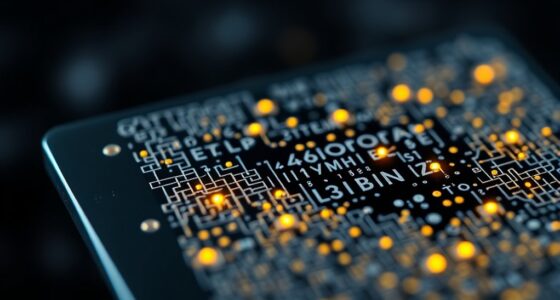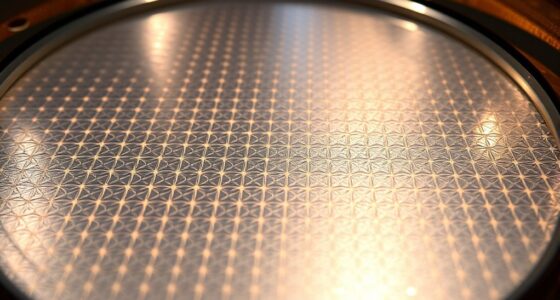Nano-sensors in smart homes detect tiny changes in temperature, humidity, light, and air quality, helping you maintain a safe and comfortable environment. They operate discreetly at a molecular level, providing continuous, real-time data to automate systems like heating, cooling, and air purification. Proper calibration guarantees their accuracy and longevity, so you get reliable performance over time. To discover how these innovative sensors can transform your home, explore more about their functions and benefits.
Key Takeaways
- Nano-sensors detect environmental changes at molecular levels, enabling precise monitoring of temperature, humidity, light, and chemical presence in smart homes.
- In-situ calibration methods ensure nano-sensor accuracy and reliability amid environmental variations, maintaining long-term performance.
- Embedded discreetly, nano-sensors facilitate real-time data collection, triggering automated responses like adjusting climate controls or alerting hazards.
- Proper calibration and durability enhance sensor lifespan, prevent false readings, and support efficient, safe home automation systems.
- Nano-sensors revolutionize smart homes by providing seamless, accurate environmental monitoring for energy efficiency, safety, and occupant comfort.

Have you ever wondered how your smart home can sense and respond to your environment so seamlessly? The answer lies in the incredible advancements of nanotechnology applications, particularly in the domain of nano-sensors. These tiny devices operate at the molecular or atomic level, allowing them to detect changes in temperature, humidity, light, or even chemical compositions with extraordinary sensitivity. As you go about your day, nano-sensors work quietly behind the scenes, continuously gathering data that helps your home adjust settings for comfort, safety, and efficiency. Their small size means they can be embedded discreetly into walls, furniture, or appliances, creating an interconnected network that provides real-time feedback.
Nano-sensors operate at the atomic level, enabling your smart home to detect environmental changes precisely and seamlessly.
But for these sensors to perform accurately, proper sensor calibration methods are essential. Calibration ensures that the data they collect is precise and reliable, which is critical for making correct adjustments in your smart home. Traditional calibration techniques can be too bulky or time-consuming for nano-sensors, so researchers have developed specialized methods suited for their scale. These include in-situ calibration, where the sensors are calibrated within their operational environment, and reference-based calibration, which compares sensor outputs against known standards. These methods help maintain the sensors’ accuracy over time, even as they are exposed to varying conditions or potential interference. Without effective calibration, nano-sensors risk delivering false data, leading to inefficient or even unsafe responses from your smart home system.
The beauty of nanotechnology applications in this context is that they enable incredibly precise and responsive sensors without adding bulk or complexity to your home. You might not see these sensors, but their impact is profound—they can detect tiny fluctuations in air quality or moisture levels, triggering air purifiers or dehumidifiers instantly. They can sense subtle changes in temperature, activating heating or cooling systems just when needed, saving energy and enhancing comfort. Additionally, nano-sensors can monitor for potential hazards, such as gas leaks or mold growth, alerting you before they become serious problems. The key to all of this is ensuring that the sensors are properly calibrated, which maximizes their effectiveness and prolongs their lifespan. Moreover, ongoing research into sensor durability ensures that these devices remain reliable over extended periods of use, even in challenging environments.
In essence, nano-sensors powered by advanced nanotechnology applications and precise calibration methods are transforming your smart home into a highly responsive, efficient, and safe environment. They do their job quietly and accurately, giving you peace of mind and control over your living space. By leveraging these tiny yet powerful devices, you can enjoy a smarter, more intuitive home that adapts effortlessly to your needs and the environment around you.
Frequently Asked Questions
How Do Nano-Sensors Improve Energy Efficiency in Smart Homes?
Nano-sensors improve your smart home’s energy efficiency by precisely monitoring energy consumption in real-time. They detect subtle changes in temperature, humidity, and light, allowing you to optimize heating, cooling, and lighting. With accurate sensor calibration, you avoid unnecessary energy use, reducing waste. This timely data helps you make smarter decisions, lowering your energy bills and environmental impact while maintaining comfort and convenience in your home.
What Are the Privacy Concerns With Nano-Sensor Data Collection?
Imagine your smart home as a vault, with nano-sensors acting as vigilant guards. You should be concerned about data security and user privacy because these tiny sensors collect detailed personal info. If hackers breach the system, your private life could be exposed. Protecting data security means encrypting data, and respecting user privacy involves transparent data collection practices. Don’t let the guards become unwelcome intruders into your personal space.
Can Nano-Sensors Detect Hazardous Environmental Pollutants?
Yes, nano-sensors can detect hazardous environmental pollutants. They excel at hazard detection by identifying pollutants like gases, chemicals, and toxins at very low concentrations. For pollutant monitoring, you benefit from their high sensitivity and rapid response times, which allow you to continuously track environmental safety inside your home. This technology helps guarantee a healthier living space by alerting you to dangerous pollutants before they reach harmful levels.
Are Nano-Sensors Safe for Long-Term Indoor Use?
Think of nano-sensors like tiny guardians; they’re generally safe for long-term indoor use, but you should stay cautious. While ongoing research shows promising biocompatibility and stability, some concerns remain about potential long-term effects. Regular updates and safety assessments help guarantee their stability, so you can confidently rely on them without worry. As with any technology, staying informed keeps your home safe and smart.
How Do Nano-Sensors Integrate With Existing Smart Home Systems?
You can easily integrate nano-sensors with your existing smart home systems through wireless connectivity, allowing seamless communication with your hub or app. First, guarantee proper sensor calibration for accurate readings. Once calibrated, the sensors connect wirelessly via protocols like Wi-Fi or Bluetooth, enabling real-time data sharing. This integration offers enhanced automation and monitoring, making your smart home more efficient and responsive to your needs.
Conclusion
As you step into your smart home, imagine nano-sensors silently working behind the scenes, detecting threats before you even notice. They hold the power to transform your living space into a fortress of safety and comfort. But what undiscovered capabilities might they hold? The future of smart homes is closer than you think, and with each tiny sensor, a new level of intelligence and security awaits—just beyond the horizon, ready to redefine your everyday life.









